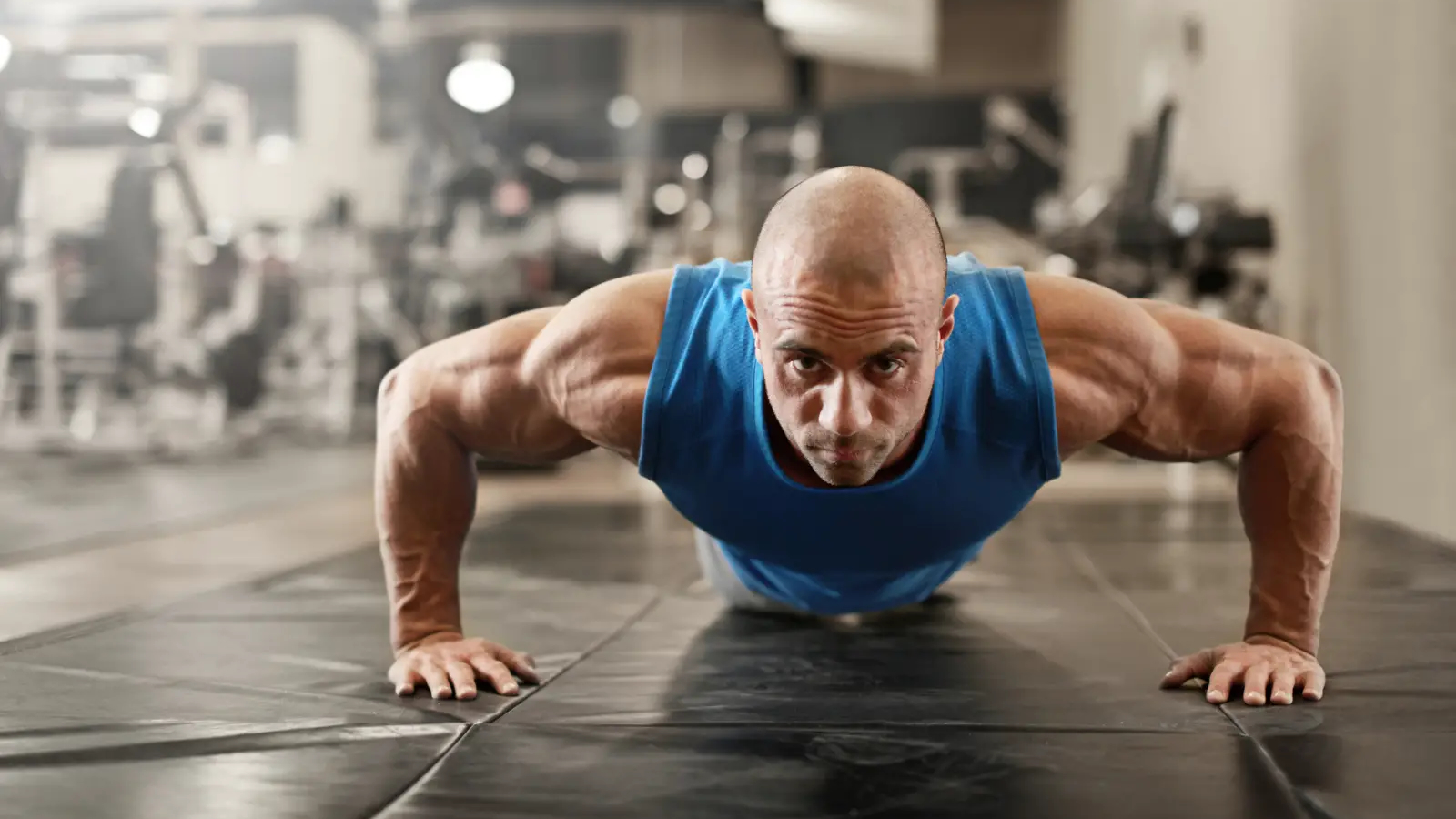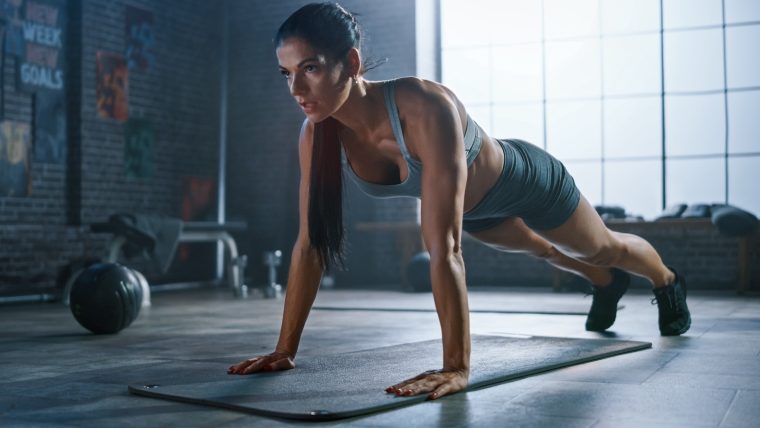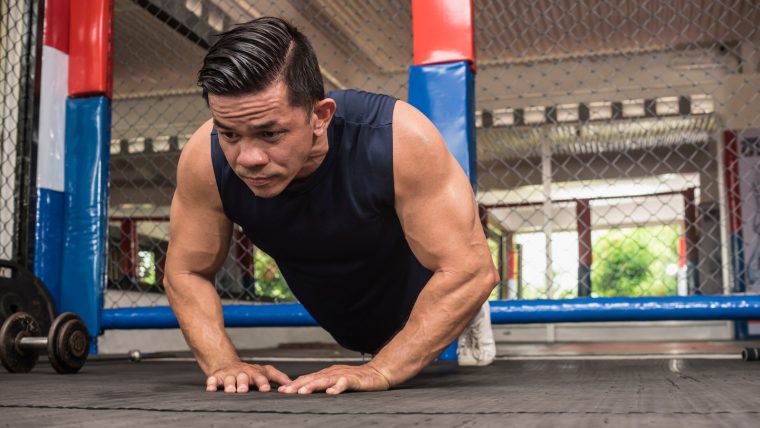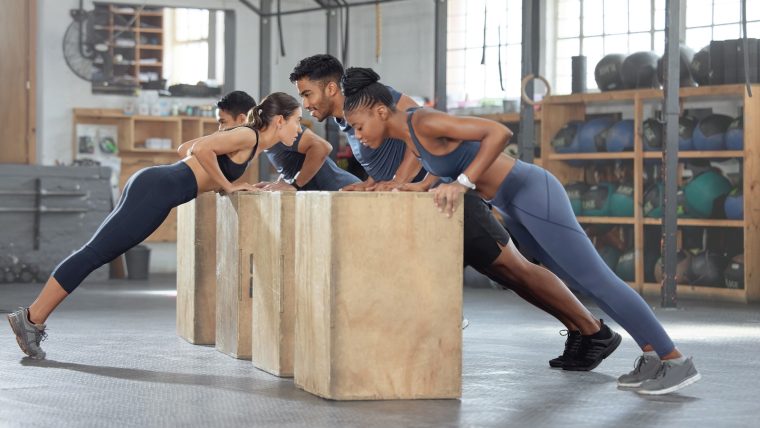
As one of the foundational movements of any workout program, the push-up is more than just a means to increase your upper body strength and endurance. Depending on your hand position, tempo, and body angle, this seemingly straightforward exercise can provide a sufficient stimulus to not only build a bigger chest but also increase your core stability and overall fitness.
In fact, studies show that a higher baseline push-up capacity is associated with lower incidence of cardiovascular disease events. (1) Plus, perfecting your technique and expanding your push-up repertoire can put you in a more advantageous position to crush compound lifts like the bench press and overhead press.

While it may seem like second nature to drop to the ground and start pumping out reps like you did in middle school gym class, the first step to maximizing your strength- and muscle-building efforts is to make sure you understand the biomechanics of the good ole’ push-up. Once you’ve really mastered the basics, you can level-up your training by swapping out the standard form of this time-tested exercise with unique push-up variations that target specific muscles more directly.
What Muscles Do Push-Ups Work?
How to Perfect Your Push-Up Technique
Luckily, the push-up is far less complicated than something like the clean & jerk. Still, it’s critical to perform any exercise with the correct technique for safety and efficiency — and it’s not different in this case.
Because push-ups can place quite a bit of stress on your wrists, being aware about the alignment of your hands can go a long way in staying pain- and injury-free. In addition, knowing how to position your elbows can make a major difference in completing a clean rep or setting the stage for potential shoulder problems.
If you want to ensure you’re getting the most bang for your buck, here’s what you need to do to perform the perfect push-up.
- Start in a “high plank” position with your hands slightly wider than your shoulders and your elbows just slightly bent. Maintain straight legs without dipping your hips toward the ground or hiking them upward.
- Engage your core by pulling your belly button toward your spine.
- Slowly lower yourself to the floor, making sure to keep your elbows tucked close to your sides as your arms bend toward a 90-degree angle.
- Once you reach the bottom of the movement, contract your chest and triceps muscles and push back through your hands until you reach the starting position.
Muscles Worked During a Push-Up
Although many people look at the push-up as solely an upper body exercise, it’s actually a closed kinetic chain movement that involves multiple muscle groups from head-to-toe. Of course, since push-ups primarily involve the pectorals (major and minor) and triceps, it’s easy to see why they’re a popular choice for chest and arm day programming.
Yet when you consider the full scope of what the movement entails, you could make the argument that a push-up is truly a full-body exercise. After all, not only do you need to utilize your pecs, triceps, and shoulders, but you also have to recruit your abdominal, lower back, and leg muscles to perform a proper rep.
Here’s a breakdown of how and when the primary and secondary muscles are recruited during a push-up.
Pectoralis Major
The largest of the chest muscles, your pectoralis major is a thick, fan-shaped muscle that acts as the agonist (primary mover) during a push-up. It consists of two heads: the clavicular (which originates from the front surface of your clavicles) and the sternocostal (which originates from your sternum and upper ribs).
The pec major lengthens and stretches as you lower yourself down during the eccentric phase of a push-up and it contracts as you push back up to the starting position.
Pectoralis Minor
Located under the pec major, the pectoralis minor is a small, triangular muscle that originates from the third to fifth ribs and inserts into your scapulae (shoulder blades). Although it pales in comparison to the size of its larger cousin, it still plays a critical role.
As you perform a push-up, the pec minor keeps your scapulae in position. However, tightness in this muscle, or having relatively weak rotator cuff or scapular stabilizers, can lead to discomfort and imbalances. This makes upper body mobility work particularly important.

Triceps
Besides the pec major, no muscle benefits more from the push-up than your triceps brachii. Located on the back of your upper arm, this three-headed monster includes the medial, lateral, and long heads — each of which has a unique origination point.
During the initial phase of a push-up, the triceps helps stabilize your torso. Then, once the muscle is under tension, it takes over as the agonist when you extend your arms to lockout the top of the movement.
Anterior Deltoids
Similar to the triceps, the deltoids are comprised of three heads (anterior, lateral, and posterior). These large, triangular muscles are located on top of your shoulder joints, with the anterior head playing the most active role during a push-up. Besides assisting with shoulder stability during the eccentric phase, your front delts also help bring your arms inward towards your chest during the concentric portion of a push-up.
Core
Your core will receive a wake-up call when you perform a push-up, too. Comprised of five main muscles — the rectus abdominis, transverse abdominis, internal and external obliques, and the relatively small pyramidalis — your abdominals work synergistically with your erector spinae to keep your torso straight throughout the movement.
Failing to keep your core engaged from start to finish can affect your total-body position and alignment. Ultimately, poor core control may put you in a compromising position that could cause problems, or even pain, down the line.
How to Target Particular Muscles During a Push-Up
The basic push-up does a solid job of recruiting several muscle groups, namely your chest and triceps, and even upper back for stability. However, you don’t always have to subscribe to the standard form, especially if you have specific muscle-building goals in mind.

Prioritize Your Triceps
To focus on building your arms, all you need to do is change your hand placement, as studies show that a narrow-width push-up provides more triceps activation. (2) The closer you put them together, the more you will shift the focus away from your pecs and toward your triceps.
While a close-grip push-up will certainly get the job done, you can make this triceps-centric exercise even more challenging by forming a diamond shape with your hands. Place your index fingers and thumbs so they touch, engage your core, and carefully lower yourself to the floor. Your triceps may detest you at the top of a diamond push-up, but they’ll thank you later for giving them direct attention with however many reps you get through.
Target Your Upper Chest
To emphasize your upper chest, steal a page from the traditional weight training playbook and press at an incline instead of a flat angle. To make this adjustment during a push-up, you must elevate your feet.
Although it may seem counterintuitive on the surface, doing a decline push-up — so named because your body is technically “declined” with your head lower than your feet — provides a stronger stimulus for the upper part of your pectoralis major than the standard version.
You can use a weight bench, plyo box, yoga blocks, or even stairs to turn an ordinary push-up into something that’ll help you develop more thickness at the top of your chest and let you fill out your t-shirts just a little bit better.
Activate Your Lower Chest
If you’re looking to build more muscle on your lower chest, take the exact opposite approach from targeting the upper portion. Rather than raising your lower body to stimulate your upper chest, place your hands on a step, platform, bench, or other apparatus to perform an incline push-up.
Changing your leverage and pressing angle in this manner will let your lower chest take on a more active role despite the more limited range of motion.
Push-Up Variations for Building Strength, Muscle, and Power
While the targeted variations outlined above are a solid start, they’re just the tip of the iceberg. Whether you’re an athlete looking to increase your power or a home gym enthusiast who wants to incorporate
How to do it:
- Start in a high plank position with your hands directly under your shoulders.
- Brace your core and lower yourself down until your elbows are at a 90-degree angle.
- Engage your chest and triceps to push upward with sufficient force so that your hands actually leave the floor. (Optional: Clap your hands together at the top.)
- Land lightly on the ground in the same starting position, then perform the next rep immediately.
Renegade Row Push-Up
You can kill two birds (aka your chest and back) with a combo move that incorporates dumbbells into the ultimate push-pull exercise. The
How to do it: Demanding, dynamic, and definitely not meant for beginners, the Spiderman push-up is a great way to get your core and lower body involved. This variation will wake up your
How to do it: Stop limiting yourself by solely sticking to the standard version. From narrowing your hand width to elevating your lower half to adding resistance, you can quickly transform the basic push-up into an exercise that’s far more dynamic, difficult, and deliberate in its purpose. Challenge yourself to try a new variation on a weekly basis, take note of any roadblocks, and keep expanding your arsenal so you can increase your strength, confidence, and coordination every time your chest hits the floor. Featured Image: ESB Basic / Shutterstock
Spiderman Push-Up
Get Creative to Get More Out of Push-Ups
References


